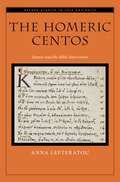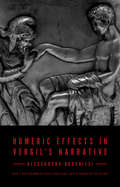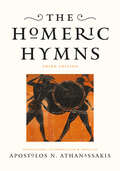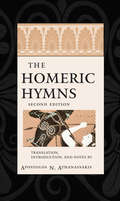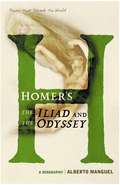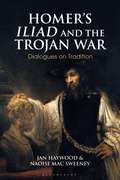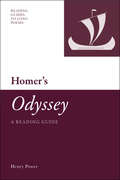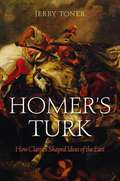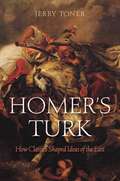- Table View
- List View
A Homeric Catalogue of Shapes: The Iliad and Odyssey Seen Differently (IMAGINES – Classical Receptions in the Visual and Performing Arts)
by Charlayn von SolmsIn the popular imagination, Homer as author of the Iliad and the Odyssey, epitomises poetic genius. So, when scholars proposed that the Homeric epics were not the unique creation of an individual author, but instead reflected a traditional compositional system developed by generations of singer-poets, swathes of assumptions about the poems and their 'author' were swept aside and called into question. Much had to be re-evaluated through a new lens. The creative process described by scholars for the Homeric epics shares many key attributes with the modern visual art-forms of collage and its less familiar variant: sculptural assemblage. A Homeric Catalogue of Shapes describes a series of twelve sculptures that together function as an abstract portrait of Homer: not a depiction of him as an individual, but as a compositional system. The technique by which the artworks were produced reflects the poetic method that scholars termed oral-formulaic. In both of these creative processes the artwork is constructed from pre-existing elements: such as phrases, characters, and plot-lines in the epics; and objects, fragmented items, and borrowed forms in the sculptures. The artist/author presents a largely unknown characterisation of Homeric poetics in a manner that emphasizes the extent and complexity of this Homer's artistry.
The Homeric Centos: Homer and the Bible Interwoven (OXFORD STUDIES IN LATE ANTIQUITY SERIES)
by Anna LefteratouThe Homeric Centos, a poem that is Homeric in style and biblical in theme, is a dramatic illustration of the creative cultural and religious dialogue between Classical Antiquity and Christianity taking place in the Roman Empire during the fifth century CE. The text is attributed to Eudocia, empress and poet, who died in exile in the Holy Land ca. 460. With lines drawn verbatim from Homer's Iliad and Odyssey, the poem begins with the Creation and Fall and ends with Jesus' Resurrection and Ascension. In this blend of Homeric style and Christian themes, there are also echoes of Classical and classicising literature, stretching from Homer and drama to imperial literature. Equally prominent are echoes of earlier Christian canonical and apocryphal works, verse models, and theological works. In The Homeric Centos: Homer and the Bible Interwoven, Anna Lefteratou analyzes the double inspiration of the poem by both classical and Christian traditions. This book explores the works relationship with the cultural milieu of the fifth century CE and offers in-depth analysis of the scenes of Creation and Fall, and Jesus' Passion, Resurrection, and Ascension. This book exposes the work's debt to centuries of Homeric reception and interpretation as well as Christian literature and exegesis, and places it at the crossroads of Christian and pagan literary traditions.
The Homeric Centos: Homer and the Bible Interwoven (OXFORD STUDIES IN LATE ANTIQUITY SERIES)
by Anna LefteratouThe Homeric Centos, a poem that is Homeric in style and biblical in theme, is a dramatic illustration of the creative cultural and religious dialogue between Classical Antiquity and Christianity taking place in the Roman Empire during the fifth century CE. The text is attributed to Eudocia, empress and poet, who died in exile in the Holy Land ca. 460. With lines drawn verbatim from Homer's Iliad and Odyssey, the poem begins with the Creation and Fall and ends with Jesus' Resurrection and Ascension. In this blend of Homeric style and Christian themes, there are also echoes of Classical and classicising literature, stretching from Homer and drama to imperial literature. Equally prominent are echoes of earlier Christian canonical and apocryphal works, verse models, and theological works. In The Homeric Centos: Homer and the Bible Interwoven, Anna Lefteratou analyzes the double inspiration of the poem by both classical and Christian traditions. This book explores the works relationship with the cultural milieu of the fifth century CE and offers in-depth analysis of the scenes of Creation and Fall, and Jesus' Passion, Resurrection, and Ascension. This book exposes the work's debt to centuries of Homeric reception and interpretation as well as Christian literature and exegesis, and places it at the crossroads of Christian and pagan literary traditions.
The Homeric Doloneia: Evolution and Shaping of Iliad 10
by Christos C. TsagalisThe Doloneia is the most controversial book of the Iliad, its authenticity having been doubted since antiquity. Modern scholars are divided between those who regard it as a major interpolation by a later poet who was trained in the technique of epic composition and those who see it as the earliest manifestation of the very ancient theme of lochos. However, the first claim assumes the stylistic homogeneity of book 10, while the second sweeps out dictional and thematic difficulties by attributing them to the theme of ambush that is weakly represented in the extant corpus of archaic Greek epic. By applying sophisticated interpretive tools such as intratextual association, intertextual allusion, and oral neoanalysis, this book maintains that Iliad 10 is thematically consonant with the rest of the Iliad and that it has evolved from an earlier Iliadic version after the addition of the Rhesus episode, which did not circulate as an independent composition but formed part of lost oral epic poetry with cyclic features that focused on the events after the death of Achilles.
The Homeric Doloneia: Evolution and Shaping of Iliad 10
by Christos C. TsagalisThe Doloneia is the most controversial book of the Iliad, its authenticity having been doubted since antiquity. Modern scholars are divided between those who regard it as a major interpolation by a later poet who was trained in the technique of epic composition and those who see it as the earliest manifestation of the very ancient theme of lochos. However, the first claim assumes the stylistic homogeneity of book 10, while the second sweeps out dictional and thematic difficulties by attributing them to the theme of ambush that is weakly represented in the extant corpus of archaic Greek epic. By applying sophisticated interpretive tools such as intratextual association, intertextual allusion, and oral neoanalysis, this book maintains that Iliad 10 is thematically consonant with the rest of the Iliad and that it has evolved from an earlier Iliadic version after the addition of the Rhesus episode, which did not circulate as an independent composition but formed part of lost oral epic poetry with cyclic features that focused on the events after the death of Achilles.
Homeric Effects in Vergil's Narrative
by Alessandro Barchiesi Ilaria Marchesi Matt Fox Philip HardieThe study of Homeric imitations in Vergil has one of the longest traditions in Western culture, starting from the very moment the Aeneid was circulated. Homeric Effects in Vergil's Narrative is the first English translation of one of the most important and influential modern studies in this tradition. In this revised and expanded edition, Alessandro Barchiesi advances innovative approaches even as he recuperates significant earlier interpretations, from Servius to G. N. Knauer.Approaching Homeric allusions in the Aeneid as "narrative effects" rather than glimpses of the creative mind of the author at work, Homeric Effects in Vergil's Narrative demonstrates how these allusions generate hesitations and questions, as well as insights and guidance, and how they participate in the creation of narrative meaning. The book also examines how layers of competing interpretations in Homer are relevant to the Aeneid, revealing again the richness of the Homeric tradition as a component of meaning in the Aeneid. Finally, Homeric Effects in Vergil's Narrative goes beyond previous studies of the Aeneid by distinguishing between two forms of Homeric intertextuality: reusing a text as an individual model or as a generic matrix.For this edition, a new chapter has been added, and in a new afterword the author puts the book in the context of changes in the study of Latin literature and intertextuality.A masterful work of classical scholarship, Homeric Effects in Vergil's Narrative also has valuable insights for the wider study of imitation, allusion, intertextuality, epic, and literary theory.
Homeric Effects in Vergil's Narrative
by Alessandro Barchiesi Ilaria Marchesi Matt Fox Philip HardieThe study of Homeric imitations in Vergil has one of the longest traditions in Western culture, starting from the very moment the Aeneid was circulated. Homeric Effects in Vergil's Narrative is the first English translation of one of the most important and influential modern studies in this tradition. In this revised and expanded edition, Alessandro Barchiesi advances innovative approaches even as he recuperates significant earlier interpretations, from Servius to G. N. Knauer.Approaching Homeric allusions in the Aeneid as "narrative effects" rather than glimpses of the creative mind of the author at work, Homeric Effects in Vergil's Narrative demonstrates how these allusions generate hesitations and questions, as well as insights and guidance, and how they participate in the creation of narrative meaning. The book also examines how layers of competing interpretations in Homer are relevant to the Aeneid, revealing again the richness of the Homeric tradition as a component of meaning in the Aeneid. Finally, Homeric Effects in Vergil's Narrative goes beyond previous studies of the Aeneid by distinguishing between two forms of Homeric intertextuality: reusing a text as an individual model or as a generic matrix.For this edition, a new chapter has been added, and in a new afterword the author puts the book in the context of changes in the study of Latin literature and intertextuality.A masterful work of classical scholarship, Homeric Effects in Vergil's Narrative also has valuable insights for the wider study of imitation, allusion, intertextuality, epic, and literary theory.
Homeric Epic and its Reception: Interpretive Essays
by Seth L. ScheinHomeric Epic and its Reception, comprising twelve chapter—some previously published but revised for this collection, and others appearing here in print for the first time—offers literary interpretations of the Iliad, the Odyssey, and the Homeric Hymn to Aphrodite. While some chapters closely study the diction, meter, style, and thematic resonance of particular passages and episodes in the Iliad and the Odyssey, others follow diverse pathways into the interpretation of the epics, including mythological allusion, intertextuality, the metrics of the Homeric hexameter, and the fundamental contrast between divinity and humanity. Also included are two chapters which focus on the work of Milman Parry and Ioannis Kakridis, founders of the two most fruitful twentieth-century scholarly approaches to Homeric scholarship: the study of the Iliad and the Odyssey as traditional oral formulaic poetry (Parry), and the study of the poems' adaptations and transformations of traditional mythology, folktales, and poetic motifs in accordance with their distinctive themes and poetic purposes (Kakridis). The volume draws to a close with three chapters which discuss some of the most compelling poetic and critical receptions of the Iliad and the Odyssey since the late nineteenth century, and the institutional reception of the epics in colleges and universities in the United States over the past two centuries. Written over a period of 45 years, this collection reflects the authors long-standing interest in, and scholarly and critical approaches to, the literary interpretation of Homeric poetry.
The Homeric Hymns
by Apostolos N. AthanassakisA rich source for students of Greek mythology and literature, the Homeric Hymns are also fine poetry. Attributed by the ancients to Homer, these prooimia, or preludes, were actually composed by various poets over centuries. They were performed at religious festivals as entertainment meant to stir up enthusiasm for far more ambitious compositions that followed them, namely the Iliad and Odyssey. Each of the thirty-three poems is written in honor of a Greek god or goddess. Together, the hymns provide a fascinating view into the ancients' view of deities. In this long-awaited third edition of his acclaimed translations of the hymns, Apostolos Athanassakis preserves the vigor and the magic of the ancient text while modernizing traditional renditions of certain epithets and formulaic phrases. He avoids lengthening or truncating lines, thereby crafting a symmetrical text, and makes an effort to keep to an iambic flow without sacrificing accuracy. Athanassakis enhances his classic work with a new index of names and topics, updated bibliography, revised genealogical charts, and careful and selective changes in the translations themselves. An expanded introduction addresses ancient reception of the hymns. Numerous additions to the notes, reflecting over twenty-five years of scholarship, draw on modern anthropological and archaeological research to explore prominent themes and religious syncretism within the poems. These materials all enrich the reader's experience of these ancient and influential poems.A perennial classroom favorite, The Homeric Hymns embodies thrilling new visions of antiquity.
The Homeric Hymns
by Apostolos N. AthanassakisA rich source for students of Greek mythology and literature, the Homeric Hymns are also fine poetry. Attributed by the ancients to Homer, these prooimia, or preludes, were actually composed by various poets over centuries. They were performed at religious festivals as entertainment meant to stir up enthusiasm for far more ambitious compositions that followed them, namely the Iliad and Odyssey. Each of the thirty-three poems is written in honor of a Greek god or goddess. Together, the hymns provide a fascinating view into the ancients' view of deities. In this long-awaited third edition of his acclaimed translations of the hymns, Apostolos Athanassakis preserves the vigor and the magic of the ancient text while modernizing traditional renditions of certain epithets and formulaic phrases. He avoids lengthening or truncating lines, thereby crafting a symmetrical text, and makes an effort to keep to an iambic flow without sacrificing accuracy. Athanassakis enhances his classic work with a new index of names and topics, updated bibliography, revised genealogical charts, and careful and selective changes in the translations themselves. An expanded introduction addresses ancient reception of the hymns. Numerous additions to the notes, reflecting over twenty-five years of scholarship, draw on modern anthropological and archaeological research to explore prominent themes and religious syncretism within the poems. These materials all enrich the reader's experience of these ancient and influential poems.A perennial classroom favorite, The Homeric Hymns embodies thrilling new visions of antiquity.
The Homeric Hymns
by Erwin CookA rich source for students of Greek mythology and literature, the Homeric hymns are also fine poetry. Attributed by the ancients to Homer, these prooimia, or preludes, were actually composed over centuries and used by poets to prepare for the singing or recitation of longer portions of the Homeric epics. In his acclaimed translations of the hymns, Apostolos Athanassakis preserves the essential simplicity of the original Greek, offering a straightforward, line-by-line translation that makes no attempts to masquerade or modernize. For this long-awaited new edition, Athanassakis enhances his classic work with a comprehensive index, careful and selective changes in the translations themselves, and numerous additions to the notes which will enrich the reader's experience of these ancient and influential poems.
The Homeric Hymns: Interpretative Essays
by Andrew FaulknerThis is the first collection of scholarly essays on the Homeric Hymns, a corpus of 33 hexameter poems celebrating gods that were probably recited at religious festivals, among other possible performance venues, and were frequently attributed in antiquity to Homer. After a general introduction to modern scholarship on the Homeric Hymns, the essays of the first part of the book examine in detail aspects of the longer narrative poems in the collection, while those of the second part give critical attention to the shorter poems and to the collection as a whole. The contributors to the volume present a wide range of stimulating views on the study of the Homeric Hymns, which have attracted much interest in recent years.
Homeric Speech and the Origins of Rhetoric
by Rachel Ahern KnudsenTraditionally, Homer's epics have been the domain of scholars and students interested in ancient Greek poetry, and Aristotle's rhetorical theory has been the domain of those interested in ancient rhetoric. Rachel Ahern Knudsen believes that this academic distinction between poetry and rhetoric should be challenged. Based on a close analysis of persuasive speeches in the Iliad, Knudsen argues that Homeric poetry displays a systematic and technical concept of rhetoric and that many Iliadic speakers in fact employ the rhetorical techniques put forward by Aristotle.Rhetoric, in its earliest formulation in ancient Greece, was conceived as the power to change a listener’s actions or attitudes through words—particularly through persuasive techniques and argumentation. Rhetoric was thus a "technical" discipline in the ancient Greek world, a craft (technê) that was rule-governed, learned, and taught. This technical understanding of rhetoric can be traced back to the works of Plato and Aristotle, which provide the earliest formal explanations of rhetoric. But do such explanations constitute the true origins of rhetoric as an identifiable, systematic practice? If not, where does a technique-driven rhetoric first appear in literary and social history? Perhaps the answer is in Homeric epics. Homeric Speech and the Origins of Rhetoric demonstrates a remarkable congruence between the rhetorical techniques used by Iliadic speakers and those collected in Aristotle's seminal treatise on rhetoric. Knudsen's claim has implications for the fields of both Homeric poetry and the history of rhetoric. In the former field, it refines and extends previous scholarship on direct speech in Homer by identifying a new dimension within Homeric speech—namely, the consistent deployment of well-defined rhetorical arguments and techniques. In the latter field, it challenges the traditional account of the development of rhetoric, probing the boundaries that currently demarcate its origins, history, and relationship to poetry.
Homeric Speech and the Origins of Rhetoric
by Rachel Ahern KnudsenTraditionally, Homer's epics have been the domain of scholars and students interested in ancient Greek poetry, and Aristotle's rhetorical theory has been the domain of those interested in ancient rhetoric. Rachel Ahern Knudsen believes that this academic distinction between poetry and rhetoric should be challenged. Based on a close analysis of persuasive speeches in the Iliad, Knudsen argues that Homeric poetry displays a systematic and technical concept of rhetoric and that many Iliadic speakers in fact employ the rhetorical techniques put forward by Aristotle.Rhetoric, in its earliest formulation in ancient Greece, was conceived as the power to change a listener’s actions or attitudes through wordsâ€�particularly through persuasive techniques and argumentation. Rhetoric was thus a "technical" discipline in the ancient Greek world, a craft (technê) that was rule-governed, learned, and taught. This technical understanding of rhetoric can be traced back to the works of Plato and Aristotle, which provide the earliest formal explanations of rhetoric. But do such explanations constitute the true origins of rhetoric as an identifiable, systematic practice? If not, where does a technique-driven rhetoric first appear in literary and social history? Perhaps the answer is in Homeric epics. Homeric Speech and the Origins of Rhetoric demonstrates a remarkable congruence between the rhetorical techniques used by Iliadic speakers and those collected in Aristotle's seminal treatise on rhetoric. Knudsen's claim has implications for the fields of both Homeric poetry and the history of rhetoric. In the former field, it refines and extends previous scholarship on direct speech in Homer by identifying a new dimension within Homeric speechâ€�namely, the consistent deployment of well-defined rhetorical arguments and techniques. In the latter field, it challenges the traditional account of the development of rhetoric, probing the boundaries that currently demarcate its origins, history, and relationship to poetry.
Homer's Ancient Readers: The Hermeneutics of Greek Epic's Earliest Exegetes (Princeton Legacy Library #5402)
by Robert Lamberton John J. KeaneyAlthough the influence of Homer on Western literature has long commanded critical attention, little has been written on how various generations of readers have found menaing in his texts. These seven essays explore the ways in which the Illiad and the Odyssey have been read from the time of Homer through the Renaissance. By asking what questions early readers expected the texts to answer and looking at how these expectations changed over time, the authors clarify the position of the Illiad and the Odyssey in the intellectual world of antiqueity while offering historical insight into the nature of reading.The collection surveys the entire field of preserved ancient interpretations of Homer, beginning with the fictional audiences portrayed within the poems themselves, proceedings to readings by Aristotle, the Stoics, and Aristarchus and Crates, and culminating in the spritiualized allegorical reading current among Platonists of the fifth and sixth centuries C.E. The influence of these ancient interpretations is then examined in Byzantium and in the Latin West during the Renaissance. Contributors to this volume are Robert Browning, Anthony Grafton, Robert Lamberton, A.A. Long, James Porter, Nicholas Richardson, and Charles Segal.Robert Lamberton is Assistant Professor of Classics and John J. Keaney is Professor of Classics, both at Princeton University.Originally published in 1992.The Princeton Legacy Library uses the latest print-on-demand technology to again make available previously out-of-print books from the distinguished backlist of Princeton University Press. These editions preserve the original texts of these important books while presenting them in durable paperback and hardcover editions. The goal of the Princeton Legacy Library is to vastly increase access to the rich scholarly heritage found in the thousands of books published by Princeton University Press since its founding in 1905.
Homer's Daughters: Women's Responses to Homer in the Twentieth Century and Beyond (Classical Presences)
by Fiona Cox Elena TheodorakopoulosThis collection of essays examines the various ways in which the Homeric epics have been responded to, reworked, and rewritten by women writers of the twentieth and early twenty-first centuries. Beginning in 1914 with the First World War, it charts this understudied strand of the history of Homeric reception over the subsequent century up to the present day, analysing the extraordinary responses both to the Odyssey and to the Iliad by women from around the world. The backgrounds of these authors and the genres they employ - memoir, poetry, children's literature, rap, novels - testify not only to the plasticity of Homeric epic, but also to the widening social classes to whom Homer appeals, and it is unsurprising to see the myriad ways in which women writers across the globe have played their part in the story of Homer's afterlife. From surrealism to successive waves of feminism to creative futures, Homer's footprint can be seen in a multitude of different literary and political movements, and the essays in this volume bring an array of critical approaches to bear on the work of authors ranging from H.D. and Simone Weil to Christa Wolf, Margaret Atwood, and Kate Tempest. Students and scholars of not only classics, but also translation studies, comparative literature, and women's writing will find much to interest them, while the volume's concluding reflections by Emily Wilson on her new translation of the Odyssey are an apt reminder to all of just how open a text can be, and of how great a difference can be made by a woman's voice.
Homer's Daughters: Women's Responses to Homer in the Twentieth Century and Beyond (Classical Presences)
This collection of essays examines the various ways in which the Homeric epics have been responded to, reworked, and rewritten by women writers of the twentieth and early twenty-first centuries. Beginning in 1914 with the First World War, it charts this understudied strand of the history of Homeric reception over the subsequent century up to the present day, analysing the extraordinary responses both to the Odyssey and to the Iliad by women from around the world. The backgrounds of these authors and the genres they employ - memoir, poetry, children's literature, rap, novels - testify not only to the plasticity of Homeric epic, but also to the widening social classes to whom Homer appeals, and it is unsurprising to see the myriad ways in which women writers across the globe have played their part in the story of Homer's afterlife. From surrealism to successive waves of feminism to creative futures, Homer's footprint can be seen in a multitude of different literary and political movements, and the essays in this volume bring an array of critical approaches to bear on the work of authors ranging from H.D. and Simone Weil to Christa Wolf, Margaret Atwood, and Kate Tempest. Students and scholars of not only classics, but also translation studies, comparative literature, and women's writing will find much to interest them, while the volume's concluding reflections by Emily Wilson on her new translation of the Odyssey are an apt reminder to all of just how open a text can be, and of how great a difference can be made by a woman's voice.
Homer's "Iliad" and "Odyssey": A Biography
by Alberto ManguelA worldwide exploration of the history, purpose, and inescapable influence of the Iliad and the Odyssey that will inspire readers to think anew about Homer’s work No one knows whether Homer was a real person, but there is no doubt that the epic poems assembled under his name are foundations of Western literature. The Iliad and the Odyssey—with their tales of the Trojan War, Achilles, Odysseus and Penelope, the Cyclops, the beautiful Helen of Troy, and the petulant gods—have inspired us for over two and a half millennia and influenced writers from Plato to Virgil, Pope to Joyce, and Dante to Margaret Atwood. In this graceful and sweeping book, Alberto Manguel traces the lineage of Homer’s poems. He examines their original purpose, either as allegory or record of history; surveys the challenges the pagan poems presented to the early Christian world; and looks at their reception after the Reformation through the present day. In this revised and expanded edition, Manguel ignites new ways of thinking about these classic works.
Homer's The Iliad and The Odyssey: A Biography (A Book that Shook the World) (BOOKS THAT SHOOK THE WORLD #9)
by Alberto ManguelThe stories of the Trojan war and Helen of Troy, Patroclus and Achilles, the Sirens and the Cyclops are embedded in western culture, yet readers often fail to recognise that they were made famous by two epic poems, The Iliad and The Odyssey, and one blind poet: Homer. Alberto Manguel begins his book with the poems' inception in ancient Greece and demonstrates how these poems have reverberated subsequently through the western canon, from the Rome of Virgil and Horace to Joyce's Dublin and Derek Walcott's Caribbean, via Dante and Racine. In this lyrical and graceful short volume, Manguel delights in the original poems and celebrates their presence throughout history.
Homer’s Iliad and the Trojan War: Dialogues on Tradition (Bloomsbury Studies in Classical Reception)
by Naoise Mac Sweeney Jan HaywoodIn this new volume, Jan Haywood and Naoíse Mac Sweeney investigate the position of Homer's Iliad within the wider Trojan War tradition through a series of detailed case studies. From ancient Mesopotamia to twenty-first century America, these examples are drawn from a range of historical and cultural contexts; and from Athenian pot paintings to twelfth-century German scholarship, they engage with a range of different media and genres. Inspired by the dialogues inherent in the process of reception, the book adopts a dialogic structure. In each chapter, paired essays by Haywood and Mac Sweeney offer contrasting authorial voices addressing a single theme, thereby drawing out connections and dissonances between a diverse suite of classical and post-classical Iliadic receptions. The resulting book offers new insights, both into individual instances of Iliadic reception in particular historical contexts, but also into the workings of a complex story tradition. The centrality of the Iliad within the wider Trojan War tradition is shown to be a function of conscious engagement not only with Iliadic content, but also with Iliadic status and the iconic idea of the Homeric.
Homer’s Iliad and the Trojan War: Dialogues on Tradition (Bloomsbury Studies in Classical Reception)
by Naoise Mac Sweeney Jan HaywoodIn this new volume, Jan Haywood and Naoíse Mac Sweeney investigate the position of Homer's Iliad within the wider Trojan War tradition through a series of detailed case studies. From ancient Mesopotamia to twenty-first century America, these examples are drawn from a range of historical and cultural contexts; and from Athenian pot paintings to twelfth-century German scholarship, they engage with a range of different media and genres. Inspired by the dialogues inherent in the process of reception, the book adopts a dialogic structure. In each chapter, paired essays by Haywood and Mac Sweeney offer contrasting authorial voices addressing a single theme, thereby drawing out connections and dissonances between a diverse suite of classical and post-classical Iliadic receptions. The resulting book offers new insights, both into individual instances of Iliadic reception in particular historical contexts, but also into the workings of a complex story tradition. The centrality of the Iliad within the wider Trojan War tradition is shown to be a function of conscious engagement not only with Iliadic content, but also with Iliadic status and the iconic idea of the Homeric.
Homer's 'Odyssey': A Reading Guide (Reading Guides to Long Poems)
by Henry PowerA fresh and exciting approach to this great work of classical literature, which brings it alive for today's students and gives them the tools to appreciate and explore the work themselves.
Homer's Turk: How Classics Shaped Ideas Of The East
by Jerry TonerSpanning the Crusades, the Indian Raj, and the postwar decline of the British Empire, Homer’s Turk illuminates how English writers of all eras have relied on Greek and Roman literature to help them understand the world once called “the Orient.” Even today, the Classics frame the West’s relationship with the Islamic world, India, and China.
Homer's Turk: How Classics Shaped Ideas Of The East
by Jerry TonerSpanning the Crusades, the Indian Raj, and the postwar decline of the British Empire, Homer’s Turk illuminates how English writers of all eras have relied on Greek and Roman literature to help them understand the world once called “the Orient.” Even today, the Classics frame the West’s relationship with the Islamic world, India, and China.
Homes and Homecomings: Gendered Histories of Domesticity and Return (Gender and History Special Issues #7)
by K. H. Adler Carrie HamiltonIn Homes and Homecomings an international group of scholars provide inspiring new historical perspectives on the politics of homes and homecomings. Using innovative methodological and theoretical approaches, the book examines case studies from Africa, Asia, the Americas and Europe. Provides inspiring new historical perspectives on the politics of homes and homecomings Takes an historical approach to a subject area that is surprisingly little historicised Features original research from a group of international scholars The book has an international approach that focuses on Africa, Asia, the Americas and East and West Europe Contains original illustrations of homes in a variety of historical contexts

